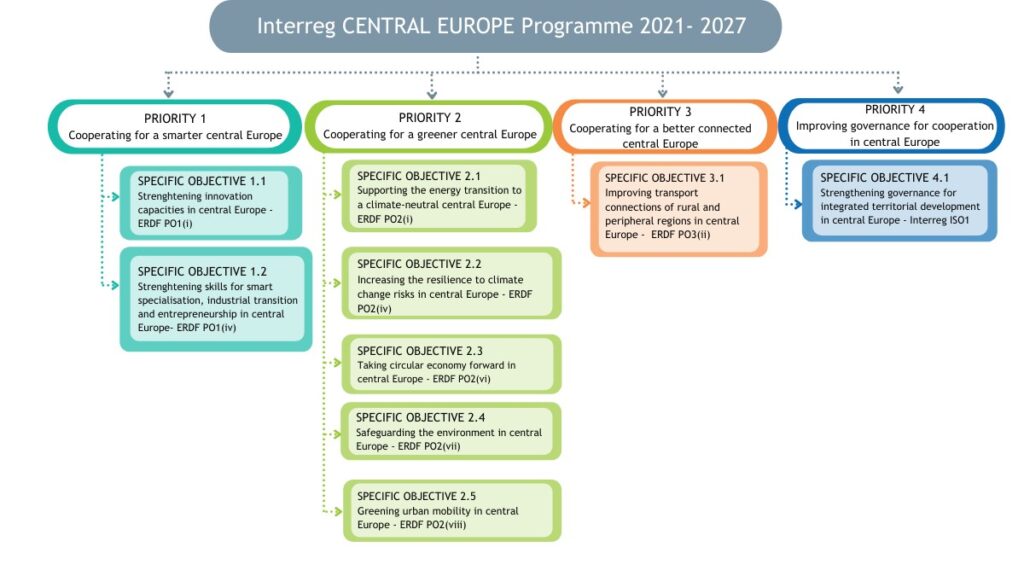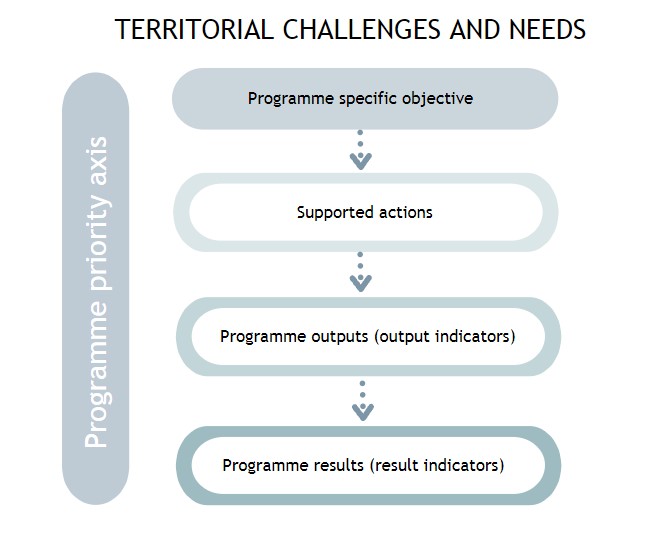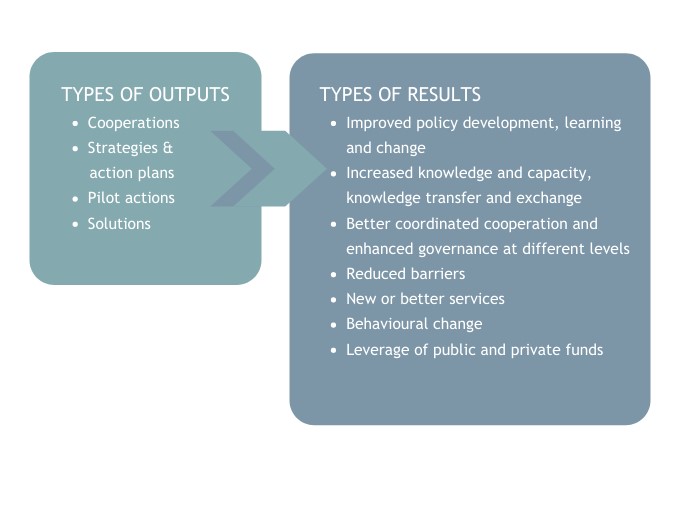I.2.1 Overview
The Interreg CE Programme is funded by the European Regional Development Fund (ERDF) under the European Territorial Cooperation goal of EU Cohesion Policy 2021-2027.

The programme area covers regions and cities from nine EU Member States: Austria, Croatia, Czech Republic, Germany, Hungary, Italy, Poland, Slovakia and Slovenia. In the current programme, the area was enlarged by Braunschweig region in Germany compared to the previous programme. The list of all participating regions is available on the programme website.
I.2.2 Programme Priorities and Specific Objectives
I.2.2.1 Programme Strategy
The Interreg CE Programme envisions a united central Europe that cooperates to become smarter, greener and better connected together. Based on shared needs and a common identity, the programme aims for a trustful culture of cooperation beyond borders.
Its mission is to bring regions and cities together beyond borders to find fitting solutions for their citizens in a fair and equal way everywhere. It encourages and supports transnational cooperation to make regions more resilient to common challenges that know no borders and which cannot be solved alone. These challenges include among others economic transition processes, climate change, and the long-term socioeconomic consequences of the Covid-19 pandemic.
The programme is organised along four funding priorities that are further broken down into nine programme specific objectives (SOs).

The programme strategy was agreed by the participating Member States following thorough consultations with more than a thousand of relevant stakeholders. The complete partner involvement process is described in the founding document for the Interreg CE Programme (IP), which is available at the programme website. This document also offers a detailed description of the challenges that affect central European regions, as well as of the above funding priorities and specific objectives.
I.2.2.2 Programme Intervention Logic
The programme intervention logic demonstrates how supported actions and developed outputs address the territorial challenges and needs tackled by the programme. It also indicates how the programme will deliver its expected results.
Programme outputs are clustered in four types:
- Cooperations;
- Strategies and action plans;
- Pilot actions;
- Solutions.

These outputs are expected to lead to programme results, which are clustered themselves in the types below:

Programme outputs and results build on outputs and results achieved by the funded projects. Therefore, there has to be a clear coherence between the project and the programme intervention logic. In order to measure the achievement of programme outputs and results, project outputs and results are captured by means of corresponding output and result indicators. Please refer to chapters I.3.2, I.3.3 and I.3.4 for more information on how to set up the project intervention logic and the video tutorials available at the programme YouTube Channel.
The intervention logic for each programme specific objective is described in detail in chapter 2 of the Interreg CE IP document, with an explanation of the specific territorial needs, thematic topics to be addressed by transnational cooperation actions and examples of actions as well as expected results.
I.2.3 Programme Budget and Co-Financing Rate
The ERDF programme budget is EUR 224.623.802, with following allocations to the four programme priorities:
| Priority | ERDF (EUR[1]) |
| P1. Cooperating for a smarter central Europe | 67.387.141 |
| P2. Cooperating for a greener central Europe | 112.311.901 |
| P3. Cooperating for a better connected central Europe | 22.462.380 |
| P4. Improving governance for cooperation in central Europe | 22.462.380 |
| TOTAL | 224.623.802 |
The indicative allocation of funds to calls for proposals is defined in the respective Terms of Reference (ToR) of the related open call, available at the programme website.
The ERDF co-financing rate is 80% for all types of beneficiaries and regions. Beneficiaries have to ensure the needed co-financing of their activities. For more information, please refer to chapter I.3.1.6.
I.2.4 Programme Governance and Management
The governance and management of the programme is shared between various bodies that, in compliance with the EU Structural Funds Regulation, are in charge of managing, coordinating, supervising and controlling the implementation of the programme.
- Monitoring Committee (MC)
The MC steers the programme, verfies its sound implementation and approves the projects for funding. It is composed of representatives of the nine Member States participating in the programme.
- Managing Authority (MA)
The MA is responsible for the management and implementation of the programme in accordance with the principle of sound financial management and in line with the applicable EU regulations. The MA also carries out the accounting function, i.e. it submits applications for payment to the European Commission and pays out ERDF co-financing to lead partners (LP).
- Joint Secretariat (JS)
The JS is established by the MA and it assists the MA and the MC in carrying out their respective functions. The JS also undertakes the day-to-day implementation of the programme and provides guidance and support to project applicants and beneficiaries.
- National Contact Points (NCP)
The nine Member States participating in the Programme established NCPs representing the programme. In cooperation with the JS, NCPs provide information to potential applicants, advise and assist beneficiaries, communicate programme achievements and support programme management.
- National Controllers
Each Member State has a control system in charge of verifying that co-financed products and services were delivered. National controllers also check the compliance of projects with applicable laws as well as programme rules and requirements. For further information on national control requirements please see chapter III.3.1.
- Audit Authority (AA) and Group of Auditors (GoA)
The AA carries out system audits and audits on projects in order to provide independent assurance to the European Commission that the programme management and control system functions effectively and that expenditure submitted to the European Commission is legal and regular. The AA is assisted by the GoA, comprising of representatives of bodies responsible for audits in each programme Member State. For further information on audits please see chapter III.3.3.
Contacts to and further information on all programme bodies are available at the programme website.
I.2.5 Joint Electronic Monitoring System (Jems)
I.2.5.1 General Information
The Interreg CE Joint Electronic Monitoring System (Jems) is a customised version of the common monitoring system developed by the Interact Programme[2], which is used by a large community of Interreg programmes.
Jems is an online system conceived to cover the full project and progamme life-cycle in one monitoring tool that allows to reduce the need for additional paper processes to a minimum. Furthermore, the concept of “one single entry point” of data is followed, avoiding multiple manual entry of the same data, through automatic transfer of data to different sections in the system. Users can fill in online forms (e.g. application, reporting, assessment) and upload or download files.
I.2.5.2 Technical Requirements
The Interreg CE Jems is available at https://jems.interreg-central.eu. It can be accessed via standard web browsers like Google Chrome, Microsoft Edge or Mozilla Firefox (recent versions). For working in Jems, it is recommended to use a PC or notebook rather than mobile devices.
I.2.5.3 Access and Support
Upon registration in Jems (https://jems.interreg-central.eu) users have access to the system as applicant users. Once a project is approved and contracted, the LP user will be assigned to the project, who in turn assigns the partner users to the project partners. Specific access rights as needed by e.g. programme bodies, controllers, external experts or auditors will be given by the system administrator through assignment of the respective role.
A helpdesk for technical support specifically dedicated to Jems can be reached via email (jems@interreg-central.eu). The “?” icon in the Jems top menu bar also provides the help contact details.
Further guidance on the different sections and features is available through the Jems helpdesk function (“?” button in the menu) at jems.interreg-central.eu.
[1] In accordance with Article 27 of the Interreg Regulation, 8% of the financial allocation of each priority is allocated to technical assistance and is identified as part of the financial allocation of each priority.
[2] For more information on the Interact Jems initiative, please visit this page: www.interact-eu.net/#o=jems.